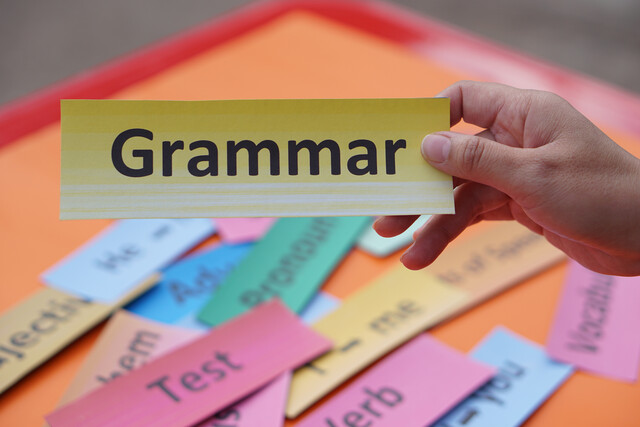English Grammar Level 3
Elevate Your English: Master Grammar with Confidence!

6 Hours average completion time
0.6 CEUs
12 Lessons
24 Exams & Assignments
13 Videos
12 Reference Files
Mobile Friendly
Last Updated October 2025
In today's fast-paced world, where written communication is paramount, the ability to write effectively is not just a skill, it's a necessity. Whether it's crafting a compelling narrative, presenting a convincing argument, or simply communicating ideas clearly, the power of writing cannot be underestimated. The English Grammar Level 3 course offers a unique opportunity to delve into the nuances of advanced grammar and writing mechanics, presenting a comprehensive platform for students to hone their writing skills.
This course is not just about learning rules; it's about understanding the mechanics of the English language and using them to create impactful, effective writing. It's designed for those who have a foundational understanding of English grammar and are ready to elevate their writing to a higher level.
In-Depth Course Narrative:
In the first lesson, "Mastering the Art of Writing," students embark on a journey into the world of creative and expressive writing. This isn't just about learning grammar rules; it's about understanding how to use these rules as tools to craft engaging narratives, compelling arguments, and clear, purposeful communication. Through a variety of techniques and exercises, students will learn how to enhance their writing style and bring their words to life.
As we move to "Crafting Effective Sentences," the focus shifts to the building blocks of writing. Here, students will explore the art of sentence construction, learning how to use varied sentence structures, effective incorporation of phrases, and the strategic use of conjunctions. The goal is to add depth and flow to their writing, transforming simple statements into powerful messages.
Building upon this foundation, the course then delves into "Building Strong Paragraphs." This lesson is about understanding how to group sentences into coherent and cohesive paragraphs. Whether it's for essays, reports, or stories, the ability to organize ideas logically and clearly is crucial. Students will learn key elements of paragraph structure and how to apply them effectively.
"Exploring Paragraph Varieties" further expands on this concept. Here, students will discover the different types of paragraphs -- expository, descriptive, narrative -- and learn how each can be used effectively to convey messages in a clear and compelling manner. This lesson is about understanding the purpose behind each paragraph type and mastering the ability to use them appropriately.
The course then takes an imaginative turn with "The Power of Showcasing vs. Telling." This lesson uncovers the secrets of 'show, don't tell' in writing. It's about learning techniques to show actions and emotions, creating a vivid picture in the reader's mind, rather than just telling them what is happening. This approach brings writing to life, making it more engaging and memorable.
In "Perspectives in Writing," the narrative shifts to the importance of point of view in writing. From first person to third person and omniscient, each perspective shapes the narrative and influences the reader's engagement with the story. Understanding these perspectives and how to use them effectively is key to powerful storytelling.
"Crafting Realistic Dialogue" explores the nuances of dialogue in writing. Students learn how to write convincing and engaging dialogue, using it as a tool to develop characters, advance the plot, and add depth to their stories. This lesson is about making conversations in writing feel real and impactful.
As students progress, "Mastering Interior Monologue" delves into the complexities of characters' thoughts and emotions. This lesson teaches how to effectively use interior monologue, a technique that adds a deeper layer to storytelling, revealing the inner workings of characters.
"The Art of Proportion in Writing" teaches students how to balance detail and pacing in their writing. This is about focusing on important events and maintaining narrative momentum, without overwhelming the reader with unnecessary details. It's a crucial skill for keeping readers engaged and ensuring that the writing is effective and purposeful.
In "Achieving Writing Sophistication," the course shifts focus to elevating the overall style of writing. This lesson provides strategies for students to enhance their writing, making it comparable to professional standards. It's about adding a level of sophistication to their work, ensuring it stands out.
"Avoiding and Replacing Poor Phrasing" addresses a common pitfall in writing. This lesson helps students identify weak phrases and replace them with stronger, more effective expressions. It focuses on refining writing for greater clarity and impact, ensuring that every word counts.
Finally, "The Essentials of Proofreading" emphasizes the importance of refining and polishing writing. Students learn techniques to catch errors and refine their drafts, ensuring their final manuscript is polished and error-free. It's about understanding that good writing is not just about what you say, but also how you say it.
Why Enroll?
English Grammar Level 3 is more than just a course; it's an opportunity to master the English language and use it as a powerful tool in both academic and professional settings. This course is ideal for students, professionals, and anyone who wishes to enhance their writing skills. Enroll now and start your journey to becoming a more effective and sophisticated writer.
- Cohesive paragraph construction
- Rich character development via interior monologue
- Enhanced narrative and expression skills
- Skillful detail and pacing balance
- Effective sentence crafting techniques
- Mastery of various paragraph styles
- Proficiency in point of view application
- Insightful dialogue creation
- Sophisticated writing style enhancement
- Refined proofreading and editing abilities
- Advanced storytelling through 'show
- don't tell'
Choose from plans starting at just $16/month (billed annually)
See Your Team Succeed
Empower your team instantly with an integrative group enrollment system. Purchase licenses in bulk with Group Discounts.



















